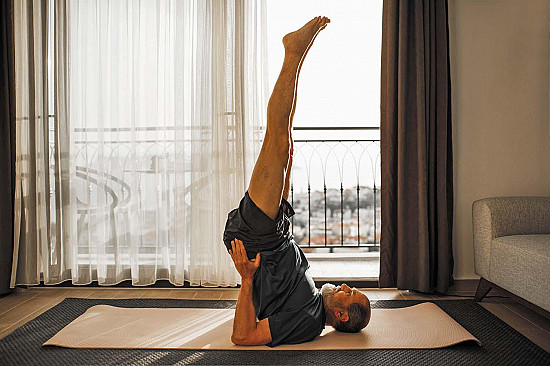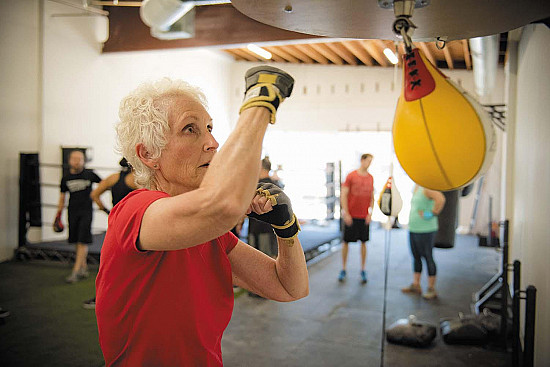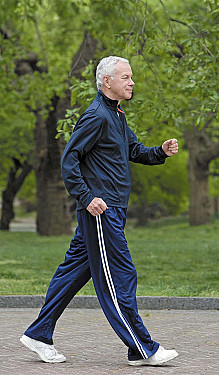Prevent falls and immobility: Start with these strength-training tips
|
Images: Thinkstock Lifting light weights is one way to build muscle strength. |
Our muscles are our first line of defense against falls, mobility loss, and bone fractures.
Strong muscles aren't just for male bodybuilders or 20-somethings. Women in their 60s and beyond also need to focus on muscle strength.
"We all want to live longer, but we want to do so independently," says Dr. Jonathan Bean, associate professor in the Department of Physical Medicine and Rehabilitation at Harvard Medical School and director of the Spaulding Center for Lifelong Health and Fitness. "Strength is one of the ingredients that's important for maintaining independence."
Muscle strengthening preserves health and prolongs life in the following ways:
-
Improving mobility. Having strong muscles is a key to staying mobile and active, both of which are essential for good health. Research finds that people who have trouble doing everyday activities like walking, climbing stairs, or getting up from a chair experience faster declines in health.
-
Preventing falls. Strong muscles in your legs and trunk help keep you upright. When these muscles weaken, you're more likely to get off-balance and fall.
-
Averting fractures. Falls contribute to most fractures in older adults. Fractures can lead to surgery, hospitalization, and loss of function, as well as to nursing home stays.
-
Reducing diabetes risk. Aerobic exercise has long been linked to a lower risk for diabetes. Now, research has shown that muscle-strengthening exercises also help women avoid this disease.
-
Preventing osteoarthritis. Exercise is known to improve pain and mobility in people who already have osteoarthritis, but some research suggests it might also help prevent the disease. Strong muscles reduce the load on joints.
Why our muscles weaken
Starting in our 30s, we gradually lose muscle mass. The rate of this decline speeds up as we age. The exact reasons for this muscle loss aren't fully understood, Dr. Bean says. If we stay inactive and don't do anything to counteract the process, by our 60s and 70s we will lose a significant amount of muscle strength.
The quality of our muscles also declines with age. "Not only do our muscles get smaller, but we also get more fat inside our muscles," Dr. Bean says. "That fat is associated with poor strength and poor power, and it relates to poor physical function."
|
Alternate speeds to build strength. |
How to rebuild muscle
You can improve muscle quality and gain strength with a combination of healthy diet and exercise. No specific foods have been proven to build muscle, but a generally well-balanced plate will keep your entire body stronger and healthier. Make sure to get enough vitamin D from foods, from the sun, and from a supplement if you and your doctor think you need it.
Strengthening muscles through exercise doesn't necessarily mean going to the gym and pumping iron. Actually, it's the combination of strength and speed of movement that is best for improving physical function, Dr. Bean says. He recommends doing power exercises that help you train for the activities of daily life, such as
-
getting up and down from a chair without using your arms as quickly as you can
-
climbing a flight of stairs as quickly as you can
-
interval training on an exercise bike, alternating a steady pace with quick bursts of speed.
Go at a speed that's fast for you, but don't push yourself beyond your limits or to the point of pain.
Incorporating weights
If you want to add weights to your workout, consider buying a weighted vest. Because it distributes the weight around your trunk, a vest doesn't put too much strain on your joints like ankle weights can. To strengthen the muscles of your arms and legs, you can also lift light weights (1 to 5 pounds).
When you're new to weight training, don't start alone. "Connect with an instructor at a local Y or wherever you exercise, and get some feedback," Dr. Bean suggests. "Or get a referral to a physical therapist who has experience working with older people."
You can also strengthen muscles in some surprising ways—by volunteering, for instance. When you donate your time, you'll engage in activities that require you to climb stairs, carry items, and walk. "Not only is that helpful for your own well-being and the people you're helping, but it also can improve your physical capacity," Dr. Bean says.
For more tips on preserving muscle strength, see the Harvard Special Health Report Strength and Power Training: A Guide for Adults of All Ages. To order, go online to /SPT or call 877-649-9457 (toll-free).
Disclaimer:
As a service to our readers, Harvard Health Publishing provides access to our library of archived content. Please note the date of last review or update on all articles.
No content on this site, regardless of date, should ever be used as a substitute for direct medical advice from your doctor or other qualified clinician.

















